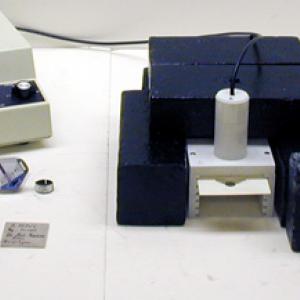College of Liberal Arts & Sciences
7D10.33 - Half-Life of Silver (NO LONGER AVAILABLE)
The silver foil must be irradiated at least overnight in the neutron howitzer. The system should be set up as in the pictures and moved into the classroom. When class has started the instructor should take at least two background radiation checks using the same timing period that will be used during sampling. It is then the job of the Lecture Demonstration Coordinator to get the sample from the neutron howitzer, run down as fast as possible and insert the sample, and begin the count. This usually takes 30 to 45 seconds. Counting is usually done for 30 seconds of each minute for 5 to 10 minutes.
The decay should be as follows:
52% of silver is Ag107
Then the reaction for this would be:
47Ag107 + 0N1 → 47Ag108
Then, 47Ag108 → e- + 48Cd108
Ag108 - 2.42m 1/2 life = B - decay - 97.5% - 1.64
MeV, B+ - 2.2% - .90 MeV
48% of silver is Ag109
Then the reaction for this would be:
47Ag109 + 0N1 → 47Ag110
Then, 47Ag110 → e- + 48Cd110
- V. J. Menon and D. C. Agrawal, "Lifetimes of Incandescent Bulbs", TPT, Vol. 41, #2, Feb 2003, p. 100.
- Christopher G. Deacon, "A Background to Background Radiation", TPT, Vol. 41, #2, Feb. 2003, p. 78.
- Editor, "Another Radioactivity Experiment Reference", TPT, Vol. 38, #3, Mar. 2000, p. 133.
- Se-yuen Mak, "Radioactivity Experiments for Project Investigation", TPT, Vol. 37, #9, Dec. 1999, p. 536.
- Bob Weinberg, "The Author Responds", TPT, Vol. 36, #3, Mar. 1998, p. 132.
- Thomas A. Walkiewicz, "Alpha Problems", TPT, Vol. 36, #3, Mar. 1998, p. 131.
- Roger Hanson, "More on Alphas", TPT, Vol. 36, #3, Mar. 1998, p. 131.
- Bob Weinberg, "The Half-Lives of Silver", TPT, Vol. 35, #8, Nov. 1997, p. 456.
- F. D. Becchetti, M. Febbraro, R. Torres-Isea, M. Ojaruega, and L. Baum, "Cf Fission-Neutron Spectrum Using a Simplified Time-of-Flight Setup: An Advanced Teaching Laboratory Experiment", AJP, Vol. 81, #2, Feb. 2013, p. 112.
- Richard E. Stevens, "Neutron Activation Analysis of a Penny", AJP, Vol. 68, #4, Apr. 2000, p. 385.
- Terrence P. Toepker, "Thorium and Yttrium in Gas Lantern Mantles", AJP, Vol. 64, #2, Feb. 1996, p. 109.
- Keith Ruddick, "Determination of the Half-Life of 212Po", AJP, Vol. 63, #7, July 1995, p. 658.
- A.A. Rollefson and R. M. Prior, "An Advanced Undergraduate Nuclear Lifetime Experiment", AJP, Vol. 46, #10, Oct. 1978, p. 1007.
- B. A. Logan, "A Source of 4.43-MeV g Rays", AJP, Vol. 46, #8, Aug. 1978, p. 866.
- G. C. Chikkur and N. Umakantha, "Half-life of Thorium - 232: A Laboratory Experiment", AJP, Vol. 45, #11, Nov. 1977, p. 1120.
- K. Gopal, H. Sanjeevaian, B. Sajeevaiah, "A Laboratory Experiment for Determining the Partial Half-Life of 40K for Beta Emission", AJP, Vol. 40, #5, May 1972, p. 721.
- Lawrence Ruby, "Demonstration of the Buildup and Decay of Radioactivity", AJP, Vol. 34, #3, Mar. 1966, p. 246.
- Julius H. Taylor and Andrea P. West, "Sources for Half-Life Experiments", AJP, Vol. 33, #12, Dec. 1965, p. 1061.
- A. R. Quinton, "Radioactive Iodine Sources", AJP, Vol. 31, #9, Sept. 1963, p. 734.
- Frank L. Moore, Jr., "Iodine Source for Half-Life Experiments", AJP, Vol. 31, #5, May 1963, p. 362.
- David Kramer, "DOE Medical Isotope Campaign Nears Completion", Physics Today, Vol. 75, #2, Feb. 2022, p. 24.
- Arthur W. Waltner, "Laboratory Experiments in Nuclear Physics", Apparatus Notes, July 1965-December 1972, p. 12.
- Dick Goodspeed, "Teaching Tip! Whole Body Radiation", Equipment & Supplies Safety, D149.
- Lederer, Hollander, Perlman, "Table of Isotopes".
Disclaimer: These demonstrations are provided only for illustrative use by persons affiliated with The University of Iowa and only under the direction of a trained instructor or physicist. The University of Iowa is not responsible for demonstrations performed by those using their own equipment or who choose to use this reference material for their own purpose. The demonstrations included here are within the public domain and can be found in materials contained in libraries, bookstores, and through electronic sources. Performing all or any portion of any of these demonstrations, with or without revisions not depicted here entails inherent risks. These risks include, without limitation, bodily injury (and possibly death), including risks to health that may be temporary or permanent and that may exacerbate a pre-existing medical condition; and property loss or damage. Anyone performing any part of these demonstrations, even with revisions, knowingly and voluntarily assumes all risks associated with them.
